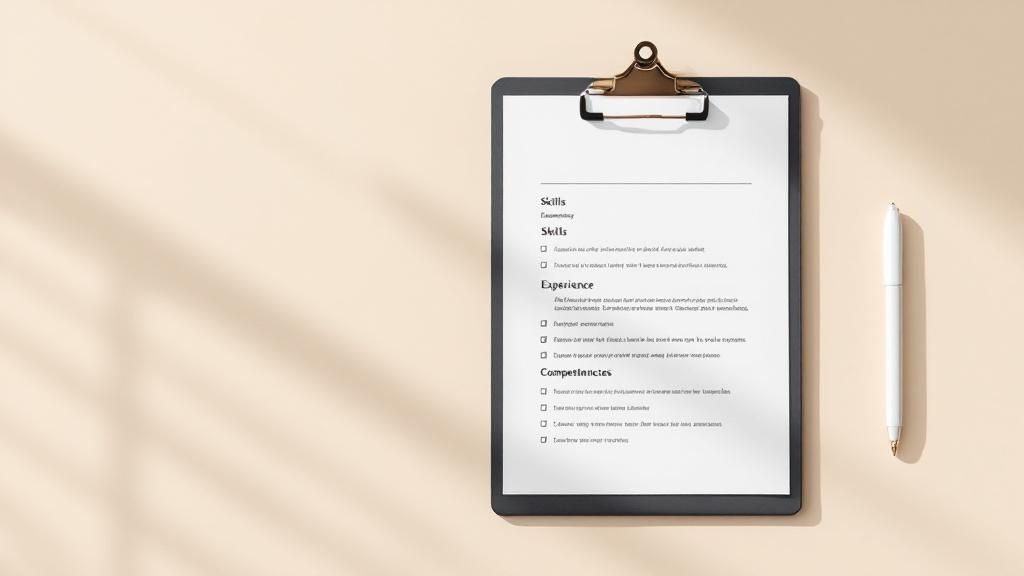August 3, 2025
8 Essential Hiring Manager Tips for 2025

In today's competitive talent market, relying on gut feelings is no longer enough. The most successful organizations understand that effective hiring is a structured, data-informed process. For hiring managers, this means moving beyond traditional interview habits and embracing strategies that consistently identify and attract top-tier talent. The pressure is on to fill roles quickly without sacrificing quality, all while ensuring fairness and a positive candidate experience.
This article provides eight essential hiring manager tips designed to streamline your recruitment efforts, reduce unconscious bias, and empower you to make confident, data-driven decisions. Each tip is a practical, actionable strategy you can implement immediately to build a stronger, more effective team and gain a competitive edge.
We'll explore how to refine every stage of the process, from defining the role to making the final offer. You will learn how to:
- Implement structured interviews and assessments.
- Focus on an exceptional candidate experience.
- Use data to remove guesswork and improve outcomes.
- Collaborate effectively with recruitment partners and stakeholders.
By the end, you'll have a clear roadmap for transforming your approach, ensuring you’re not just filling a vacancy but making a strategic investment in your company's future.
1. Define Clear Job Requirements and Competencies
The foundation of any successful hire is a crystal-clear understanding of the role itself. Before you ever post a job opening, you must meticulously define the specific skills, qualifications, and behavioral competencies required for success. This foundational step is one of the most crucial hiring manager tips because it prevents ambiguity, attracts the right talent, and creates a fair evaluation process from the very beginning. Ambiguous requirements lead to a diluted talent pool and subjective, often biased, decision-making.

This process goes beyond a simple list of duties. It involves creating a precise blueprint for your ideal candidate. For example, Amazon famously integrates its 16 Leadership Principles into every job description, ensuring candidates are evaluated not just on technical skill but on cultural alignment. Similarly, Google’s engineering roles specify required programming languages and the expected complexity of project experience, leaving no room for interpretation.
How to Implement This Strategy
To put this into practice, start by separating qualifications into two distinct categories:
- Must-Haves: These are the non-negotiable skills and experiences essential for performing the job from day one. For a Senior Accountant, this might include a CPA license and 5+ years of experience with GAAP.
- Nice-to-Haves: These are desirable but not critical qualifications that could enhance a candidate's performance, such as experience with a specific ERP software or a background in a particular industry.
Actionable Tips for Success
Collaborate with current top performers in similar roles to identify the key competencies that drive their success. When writing the description, use strong action verbs and quantifiable metrics, such as “Manage a marketing budget of over $500,000” instead of “Responsible for marketing budget.” Finally, regularly review and update job descriptions to reflect the evolving needs of the role and the team, ensuring they always include inclusive language to attract the broadest and most diverse talent pool possible.
2. Implement Structured Interview Processes
Moving beyond unstructured, "go-with-your-gut" conversations is essential for making objective and effective hiring decisions. Implementing a structured interview process means using a standardized format with predetermined questions and consistent evaluation criteria for every candidate. This methodical approach is one of the most powerful hiring manager tips because it minimizes bias, ensures fairness, and provides a reliable framework for comparing candidates against the core competencies of the role, not just on rapport.

This strategy, championed by experts like former Google VP Laszlo Bock, is designed to gather relevant, job-specific data. For instance, Salesforce uses its V2MOM (Vision, Values, Methods, Obstacles, Measures) framework to structure interview questions, ensuring every candidate is assessed on their alignment with company strategy. Similarly, Netflix conducts rigorous culture-fit interviews with specific questions tied directly to its famed culture memo, guaranteeing that new hires will thrive in their unique environment.
How to Implement This Strategy
To adopt this method, create a dedicated interview guide for each role. This guide should include a mix of behavioral, situational, and technical questions directly linked to the "must-have" competencies you defined earlier. Every interviewer asking questions for a specific role should use the same core questions and a scoring rubric to grade responses objectively.
- Behavioral Questions: These explore past performance. Ask candidates to describe specific situations using the STAR method (Situation, Task, Action, Result) to provide concrete evidence of their skills.
- Situational Questions: These present hypothetical workplace scenarios to gauge problem-solving skills and judgment.
- Scoring Rubric: Develop a simple 1-5 scale to rate answers based on predefined criteria for what constitutes a poor, average, or excellent response.
Actionable Tips for Success
First, train all interviewers on the structured process, emphasizing unconscious bias awareness and proper questioning techniques. Develop a role-specific guide with 8-10 core questions that everyone will ask. After each interview, require interviewers to immediately document their notes and scores in your applicant tracking system to ensure accurate, timely feedback for comparison. This discipline prevents recall bias and leads to more defensible, data-driven hiring decisions.
3. Leverage Multiple Assessment Methods
Relying solely on interviews to evaluate a candidate is like trying to understand a complex movie by only watching the trailer. It provides a glimpse but lacks the depth needed for an informed decision. An essential hiring manager tip is to leverage a combination of assessment methods to gain a holistic view of a candidate’s abilities, problem-solving skills, and potential cultural alignment. This multi-faceted approach validates the claims made on a resume and in an interview, leading to more accurate predictions of on-the-job performance.

This strategy moves beyond conversation and into practical application. For instance, consulting firm McKinsey & Company famously uses rigorous case study interviews to see how candidates structure problems and communicate solutions under pressure. Similarly, Atlassian incorporates pair programming sessions into its technical interviews, allowing hiring teams to observe a candidate's collaborative and coding skills in a real-world scenario. This approach, championed by figures like former Zappos CEO Tony Hsieh for cultural assessments, ensures you’re evaluating the whole candidate, not just their interview persona.
How to Implement This Strategy
The key is to layer different types of evaluations throughout the hiring process, each designed to measure a specific competency defined in your job requirements.
- Technical Skills: Use work sample tests, coding challenges (like those on HackerRank), or portfolio reviews. For a graphic designer, this means reviewing their portfolio; for a developer, a code sample.
- Problem-Solving & Critical Thinking: Employ case studies or hypothetical business problems relevant to the role. This reveals a candidate’s thought process and strategic thinking.
- Cultural & Behavioral Fit: Integrate behavioral interview questions, team-based activities, or even paid trial periods to see how a candidate interacts with the team and aligns with company values.
Actionable Tips for Success
Tailor your assessments directly to the job’s core functions; a one-size-fits-all test is rarely effective. Always provide clear instructions, context, and reasonable time limits to set candidates up for success. When possible, use validated, third-party assessment tools rather than creating them from scratch to avoid inherent bias. Finally, conduct thorough reference checks with former direct supervisors, asking specific, performance-related questions to corroborate the skills and behaviors you observed during the process.
4. Focus on Candidate Experience Throughout the Process
Every interaction a candidate has with your company is a reflection of your brand, culture, and values. Focusing on the candidate experience means treating every applicant with respect, professionalism, and transparency, regardless of the hiring outcome. This is a critical hiring manager tip because a negative experience can damage your employer brand and deter future talent, while a positive one can turn candidates into brand ambassadors, customers, or even future hires for different roles.

The goal is to create a seamless, communicative, and respectful journey from application to final decision. For instance, HubSpot provides candidates with detailed interview process guides, setting clear expectations. Similarly, Buffer champions radical transparency by sharing salary information and internal culture documents upfront. These practices demystify the hiring process and build trust, showing candidates they are valued from the very first touchpoint.
How to Implement This Strategy
To elevate your candidate experience, map out the entire candidate journey and identify key communication points. Define your service level agreements (SLAs) for communication and stick to them.
- Initial Engagement: Acknowledge every application with an automated but personalized email confirming receipt and outlining the next steps and general timeline.
- Interview Logistics: Send clear, detailed confirmation emails for every scheduled interview. Include the date, time, location (or video link), names and roles of interviewers, and an agenda.
- Post-Interview Communication: Provide timely and constructive feedback. Even if a candidate isn't a fit, a respectful and prompt rejection preserves the relationship and your company's reputation.
Actionable Tips for Success
Always provide a realistic job preview that covers both the exciting opportunities and the inherent challenges of the role. Respond to all interviewed candidates, ideally within one week of their final interview, to prevent them from feeling left in the dark. Finally, create a simple feedback mechanism, like a short survey for all candidates who complete an interview, to continuously improve your process. A well-managed process ensures you improve candidate experience and strengthen your employer brand.
5. Build and Maintain Talent Pipelines
The best hiring managers don't start recruiting when a position opens; they engage in continuous recruitment. Building and maintaining a talent pipeline means proactively developing relationships with potential candidates before you have an immediate need. This strategic foresight transforms hiring from a reactive, urgent scramble into a deliberate, well-managed process. It significantly reduces time-to-hire, improves the quality of candidates, and provides a competitive advantage in a tight labor market.
This long-term approach is a cornerstone of modern talent acquisition. For instance, LinkedIn actively cultivates networks of engineering talent, engaging them with tech talks and content long before a specific role is available. Similarly, Apple fosters deep, long-term relationships with top university programs to identify and nurture the next generation of innovators. This strategy ensures a warm pool of pre-vetted, interested candidates is always on standby.
How to Implement This Strategy
Begin by shifting your mindset from filling a single job to building a community. This involves consistent networking, engagement, and relationship management. Use your Applicant Tracking System (ATS) or a dedicated CRM to organize and track promising individuals, including past applicants who were strong but not the right fit at the time.
- Active Sourcing: Regularly browse professional networks like LinkedIn for high-potential individuals, even if you aren't hiring for their specific role yet. Engage with their content and make initial, low-pressure connections.
- Passive Engagement: Develop content marketing, such as blog posts, webinars, or company culture showcases, that attracts passive candidates and keeps your organization top-of-mind as a desirable place to work. Learn more about effective candidate sourcing strategies on klearskill.com.
Actionable Tips for Success
Tag promising "silver medalist" candidates in your ATS with notes on their strengths for future openings. Attend industry conferences and maintain an active professional social media presence to build your network. You can also empower your team by creating employee ambassador programs for university and community outreach, leveraging their networks to connect with exceptional talent. This proactive approach is one of the most effective hiring manager tips for ensuring you never start from scratch.
6. Reduce Unconscious Bias in Hiring Decisions
Even the most well-intentioned managers are susceptible to unconscious biases, which can subtly influence decisions and undermine efforts to build a diverse, high-performing team. These mental shortcuts, based on stereotypes and assumptions, can lead to overlooking exceptional candidates who don't fit a conventional mold. Implementing systematic approaches to mitigate bias is a critical hiring manager tip that ensures evaluations are based purely on merit, skill, and potential, fostering a fairer process and stronger business outcomes.
This strategy involves moving from subjective "gut feelings" to objective, evidence-based decision-making. For instance, Salesforce champions this by conducting annual pay equity assessments and mandating bias awareness training for all hiring managers. Similarly, Johnson & Johnson has embedded inclusive hiring practices across its organization, famously utilizing diverse interview panels to ensure multiple perspectives are included in every final hiring decision, preventing affinity bias from taking hold. These companies prove that a structured approach is essential for true equity.
How to Implement This Strategy
To actively reduce bias, you must build objectivity directly into your recruitment workflow. This means standardizing the points of evaluation for every candidate, ensuring everyone is measured against the same predetermined, job-relevant criteria. It requires a conscious effort to dismantle processes that allow for subjective judgment to creep in.
- Blind Resume Reviews: Start by anonymizing resumes for the initial screening. Remove names, photos, graduation years, and addresses to focus solely on skills and experience.
- Structured Decision-Making: Use a scoring rubric tied to the core competencies defined in the job description. This forces interviewers to justify their ratings with specific evidence from the interview.
Actionable Tips for Success
Incorporate diverse interview panels, ensuring at least one member is from an underrepresented group to challenge groupthink and provide varied viewpoints. Regularly audit your hiring data, looking for patterns that might indicate bias in sourcing, screening, or selection stages. Finally, continue educating yourself and your team on the different types of bias and explore further recruitment best practices on klearskill.com to refine your approach. This commitment to continuous improvement is key to building a truly inclusive hiring culture.
7. Make Data-Driven Hiring Decisions
Moving beyond intuition and "gut feelings" is a hallmark of an exceptional hiring manager. Making data-driven hiring decisions means leveraging analytics and quantitative insights to inform your strategy, evaluate candidates, and optimize the entire recruitment process. This approach replaces subjective bias with objective evidence, leading to more consistent, predictable, and successful hiring outcomes. Relying on data helps you understand what truly works, justifying your decisions and improving your ability to find top-tier talent.
This method involves transforming recruitment from an art into a science. For instance, Google's famous people analytics team, formerly led by Laszlo Bock, analyzed years of hiring and performance data to identify the key predictors of success, discovering that work sample tests and structured interviews were far more effective than unstructured conversations or resume credentials. Similarly, Unilever uses gamified assessments and AI to analyze candidate traits, generating data that predicts future job performance and cultural fit with remarkable accuracy.
How to Implement This Strategy
To begin, focus on tracking a few core metrics that directly impact your hiring success. Avoid analysis paralysis by starting small and building from there. Create a simple dashboard or spreadsheet to monitor these key performance indicators (KPIs) over time.
- Establish Key Metrics: Define what success looks like in measurable terms. This includes time-to-hire, cost-per-hire, source-of-hire effectiveness, and most importantly, quality-of-hire (e.g., first-year performance review scores of new employees).
- Analyze Your Best Hires: Look back at your top performers. What common traits, interview scores, or sourcing channels did they share? Use this data to build a predictive model for what to look for in future candidates.
Actionable Tips for Success
Build a culture of data-informed decision-making within your interview panel by sharing performance dashboards and insights regularly. Use applicant tracking system (ATS) data to analyze your hiring funnel, identifying where you lose the best candidates and why. Finally, analyze patterns in successful hires to refine your job descriptions and interview questions, ensuring you’re actively screening for the characteristics that have proven to lead to long-term success on your team. This continuous feedback loop is one of the most powerful hiring manager tips for sustained improvement.
8. Collaborate Effectively with Stakeholders
Hiring is a team sport, not a solo mission. To consistently make the best hires, you must build strong, collaborative partnerships with HR, recruiters, executives, and other key stakeholders. This alignment ensures everyone is working from the same playbook, with shared goals and accountability. This collaborative approach is a vital hiring manager tip because it prevents silos, reduces friction, and leverages collective intelligence to make more robust and well-rounded hiring decisions.
This synergy transforms the recruitment process from a series of handoffs into a unified effort. For instance, Microsoft employs collaborative hiring committees with cross-functional representation to evaluate candidates from multiple perspectives, ensuring a holistic assessment of skill and cultural fit. Similarly, Adobe’s model fosters a tight partnership between hiring managers and recruiters, treating them as co-owners of the search and empowering them to strategize together on everything from sourcing to closing candidates.
How to Implement This Strategy
Begin by defining roles and responsibilities clearly at the outset of every search. Who is responsible for sourcing, screening, interviewing, and making the final decision? Clarifying this creates a smooth workflow and prevents critical tasks from falling through the cracks.
- Establish Clear Communication: Set up a regular cadence for check-ins, whether it's a daily stand-up with the recruiter or a weekly sync with the broader interview panel.
- Create Shared Visibility: Use a shared document or applicant tracking system (ATS) to centralize candidate information, feedback, and status updates. This transparency keeps everyone aligned and informed in real-time.
Actionable Tips for Success
Set realistic expectations with stakeholders regarding timelines, market conditions, and the ideal candidate profile. Be transparent about challenges and work together to pivot strategy when needed. Develop clear escalation paths for resolving disagreements or delays, ensuring that a single point of friction doesn't derail the entire process. Ultimately, fostering a culture of shared accountability, as championed by leaders like Satya Nadella, ensures that every stakeholder is invested in the long-term success of the new hire.
Key Hiring Manager Tips Comparison
Your Blueprint for Strategic Hiring Success
Navigating the complexities of modern recruitment requires more than just intuition; it demands a strategic, repeatable, and human-centric approach. The hiring manager tips outlined in this guide serve as a comprehensive blueprint to elevate your process from a simple function to a core business advantage. By moving beyond reactive vacancy filling and embracing a more deliberate methodology, you fundamentally change your organization's trajectory, one exceptional hire at a time.
The journey begins with clarity and structure. Defining precise job requirements and implementing structured interviews are not just administrative tasks; they are foundational pillars that ensure fairness, consistency, and alignment. When you know exactly what you’re looking for and ask every candidate the same core questions, you create a level playing field where true merit can shine through. This structured approach, combined with a focus on mitigating unconscious bias, directly contributes to building more diverse, innovative, and resilient teams.
From Process to Partnership
Effective hiring is a team sport. Collaborating closely with all stakeholders, from HR partners to interview panelists, ensures everyone is aligned on the ideal candidate profile and the evaluation criteria. This collaborative spirit must extend to the candidates themselves. Treating every applicant with respect and prioritizing a positive candidate experience, regardless of the outcome, builds your employer brand and strengthens your future talent pipelines. Remember, today's silver medalist could be tomorrow's perfect hire for another role.
Making data-driven decisions is the final piece of this strategic puzzle. By tracking key metrics, analyzing your pipeline, and leveraging robust assessment methods, you replace guesswork with actionable insights. These hiring manager tips are not isolated tactics but interconnected components of a holistic system.
Your Actionable Next Steps
To turn these concepts into reality, start with a focused approach. Don't try to overhaul everything at once. Instead, choose one or two key areas for immediate improvement:
- This Quarter's Goal: Select one high-priority role and commit to creating a fully structured interview kit for it, complete with a scorecard and competency-based questions.
- Data Deep Dive: Schedule a meeting with your team to review hiring data from the past six months. Identify one key bottleneck, such as time-to-hire or offer acceptance rate, and brainstorm three specific actions to address it.
- Candidate Experience Audit: Map out your current candidate journey from application to final decision. Identify one point of friction and implement a change to improve it, such as sending more proactive communication or providing interview feedback.
By consistently applying these principles, you will not only fill roles more efficiently but also attract and retain the high-performing talent that will drive your organization’s future success. This is the ultimate value of mastering these hiring manager tips: transforming your recruitment function into a powerful engine for sustained growth and innovation.
Ready to supercharge your hiring process and eliminate bias at the source? Klearskill automates the most time-consuming screening tasks with AI-powered, role-specific challenges, allowing you to focus on the best-fit candidates from day one. See how our platform can help you implement these hiring manager tips with unmatched efficiency and fairness by visiting Klearskill today.
